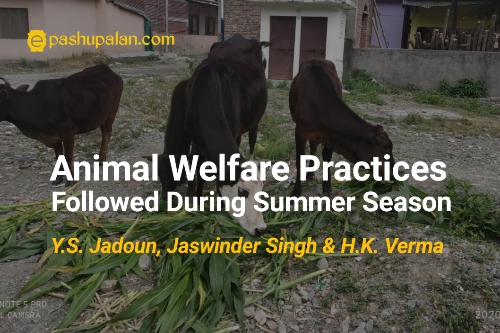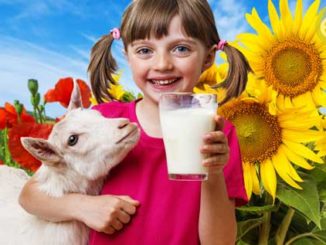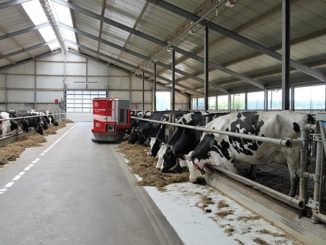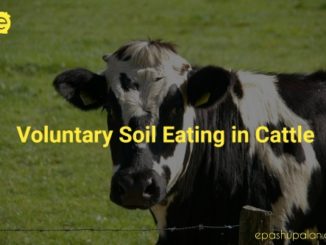Animal welfare is undertaking micro animal husbandry practices on the livestock at the farm, and is directly related to health, reproduction & production of animals under comfortable as well as animal friendly environment. Animal welfare practices have a positive effect on production and reproduction performance of dairy animals.

Animal welfare aim is to provide five freedoms to animal from:-
- Hunger, malnutrition and thirst; (through access to feeding and fresh water to maintain physical strength and good health)
- Fear and distress; (by creating conditions and alleviating mental suffering through timely treatment )
- Heat stress or physical discomfort; (suitable and comfortable environment including shelter, bedding material, resting area)
- Pain, injury and disease; (by deworming, rapid diagnosis, prevention and treatment / medication & vaccination)
- Express normal patterns of behaviour; (by providing proper facilities, sufficient space and company of the animal’s own kin )
(www.oie.int)
Conditions and availability of resources in all the farms including commercial livestock industry may not be constant all year around. These can differ greatly depending on the season of year; however an acceptable level of animal welfare must be maintained throughout the year. Everyone welcome the warm weather and longer days of summer season, but with changing weather patterns and a shift towards higher temperatures, extreme heat is emerging as an issue for all livestock and homosapiens. Amongst the environmental factors, hot ambient temperature, high humidity and solar radiations reduce an animal’s ability to dissipate body heat resulting in greater core body temperature and potentially reduced animal well-being that have significant impact on the production and reproduction performance of all livestock species. However, livestock can utilize adaptive physiological mechanisms to compensate. While these mechanisms promote animal survival, they are often unfavorable to efficient livestock production (Valtorta, 2002) resulting in economic losses as nutrients are diverted to preserve euthermia and product synthesis is de-emphasized (Johnson et al., 2015a). At high ambient temperature the animals waste their feed energy in Panting and Sweating, the nature’s way of cooling by evaporation. During summer the milk production is reduced even to 50%. Crossbred / exotic animals are more prone to the heat/summer stress losses as compared to indigenous cattle (Belsare and Pandey, 2008), the later being well adapted to local conditions.
Armstrong (1994) reported following responses in animals during heat/summer stress;
- Reduced feed intake
- Increase water intake
- Change in the metabolic rate / maintenance requirement.
- Increased evaporative loss
- Changes in blood hormones concentrations.
- Increase body temperature.
All these responses collectively get reflected in reduction of milk yield and reproduction efficiency. To overcome this situation, good planning and animal welfare practices are required for the management of animals during hot conditions. Keeping an eye on the weather forecasts as well as previous years records; developing a plan for days of high to extreme temperature is essential in ensuring that animals suffer less and have proper and comfortable environment to survive in such hot and stressful climatic conditions. As extreme heat causes significant stress on animals, simple measures can be followed to decrease the impact of high temperature on animals.
A. General Management Practices during Summer Season
1. Watering and Feeding Management
1.1 Water
The availability fresh, clean, cool water is essential both for drinking and bathing/wallowing purpose for animals.
(a) Drinking: Intake of sufficient fresh and clean water is probably the most important strategy for animals during heat stress and temperature of water should be around 22-30 0C. Provide clean, fresh and cool drinking water 3-4 times a day. Water troughs or containers should be clean, large enough and concrete and designed in such a way that all animals have easy access. Animals should be familiar to water sources before an extreme weather conditions and care should be taken that these water sources should be close enough to shelter inside the barn so that the animals should have easy access to drinking water. The number of watering points or sources should be increased if a large number of animals are kept together so it does not result in overcrowding around one source of water and prevent aggressive attacks at water troughs with fellow animals.
(Regularly clean water troughs with lime powder; never use plastic drums or containers)
(b) Bathing / showering: – Heat stress during summer season can be managed by spraying, showering, fogging and splashing of water on animals, 3-4 times during the peak hours of day. Fans in combination with sprinkling of water provide the best cooling which can reduce the heat stress in animals and are able to perform better w.r.t. productive as well as reproductive performances. In buffaloes wallowing is the choicest and effective way to beat the heat in summers. Buffaloes are made to wallow in clusters in ponds, rivers, tanks or other water bodies for hours together to heat loss in view of the labile body temperature which enables the animal to store body temperature.
(Never wallow/ bath thirsty animals)
1.2 Feeding
Nutrition plays a major role in keeping the animals healthy and fighting off diseases naturally.In summer feeding or grazing if possible should be practiced during early morning and late hours to avoid the scorching heat i.e. feed during cooler hours of day.In hot conditions high quality forages and balanced rations should be provided as these will decrease some of the effects of heat stress and will boost reproduction and production performance of the animals. Some nutritional management tips to manage heat stress include:
- High quality feeds and fodder or total mixed rations can be provided.
- Increase the frequency of feedings
- Fodder must be provided as fresh as possible
- Potassium, sodium, vitamins and mineral mixture supplementation should be preferred for maintaining milk yield.
(Feeding should be based on Age, Parity and stage of lactation of dairy animals.)
B) Shelter Management
Animal shelter has a significant bearing on the production and reproduction status of animals. Good animal shelter not only increases the production of milk but also improves the health of animals. Animal sheds under Indian conditions should be designed to reduce the heat stress, as it causes more damage to animals compared to winter and its long axis should be in East-West direction, which provides a cooler environment (Kelly et al, 1950). Good shelter during extreme summer protects the animals from the sun and also allows for the cooling effect of wind. Shelter is especially important for very young or old animals, sick or poor condition animals. A good animal shelter should have following criteria;
- Minimum roof height should be 10-12 feet and for hot climatic areas, it should be between around 12-15 feet.
- Animal shelter should be clean, dry, airy, well ventilated and should be spacious so as to provide enough space for each animal to feel comfortable.
- Ensure that the animals need to be provided with shelter / kept under shades during extended periods of extreme temperatures. Plantation around the farm will help in alleviating heat load from the animals.
- During extreme heat conditions, wind flow is important for keeping animals cool, so this should be considered when deciding type and location of shelter.
But, in today’s commercial dairy industry, it is not always practicable. Therefore, provision of artificial Shelter can keep the animals away from direct solar radiation or hot weather.
1.1 Natural Shade/shelter:
Trees are the most effective excellent source of shade and trees with large canopies can be planted individually in fields as they have a cooling effect due to absorption of heat by the leaves and if given the choice, animals feel comfortable under trees rather than constructed structures.
1.2 Artificial Shelter:
Constructed shelters are made by using materials such as plastic sheets, corrugated iron, timber Aluminum or galvanized steel etc. In general farm practices if the trees are not available thatched roof or agro nets should be use. Materials like paddy straw, painting the roof with white paint or a false ceiling insulation will help provide a cooler environment or by using wet cloth or wet gunny bags for creating the thatched walls against hot winds.
Good and comfortable shelter for all animals is an important management practice that has shown good result such as better milk production, growth rates and decreased infertility.
(Housing should be based on type and species of animals, local environment and farm category)
C. Handling
Research has shown that movement or handling of animals during hot weather can increase their body temperature by 0.5 to 3.5° C. Increased body temperature or heat stress will cause production as well as reproduction losses and has adverse impact on maintaining their normal physiology. Generally it is recommended not to handle animals in extreme heat unless absolutely necessary. If it is necessary to handle the animals (for medication purpose) be calm, move slowly , avoid crowd and loud noises and make sure it is done in early or late hours of the day. Movement of animals during cooler hours can decrease the impact of high temperatures on production performance through utilization of energy for physiological functioning.
(Rough handling of animals in harsh weather leads to severe stress causing injuries and delayed healing)
D. Transportation
Transport of animals should be avoided during extreme climate that compromises the animals’ welfare. But if transportation is utmost necessary, plan the journey and route first, to minimize the effects of transportation stress coupled with hot weather. Undue stress during transportation can be mitigated through:
- Pre-determine the route, mark-out on map with places of shade and water availability (eg. rest-stops).
- Transport the animals in such a way that does not cause any injury or suffering.
- Healthy animals should be transported and a qualified veterinarian should certify it.
- Proper bedding, adequate space for each animal and their number should be according to available area in the vehicle, so that every animal has proper space and choice to move easily.
- Animals should only be transported during the cooler hours of the day i.e. delay loading and transport of animals during extremely hot periods.
- Monitor weather conditions closely and adjust ventilation accordingly. Usually journeys should be short and direct, without any stoppage. If it is necessary to stop during transportation, park the vehicle in the shade and observe that proper air flow is occurring between animals.
- Duration of stops should be kept to a minimum to prevent the build-up of heat while the vehicle is stationary.
(Air circulation is the key for comfortable transportation)
E. Breeding Management
The significance of seasonal fluctuations in the components of the reproductive cycle is complex phenomenon. In animals, heat stress and high environmental temperature can have large effects on most aspects of reproductive function causing delayed puberty and onset of sexual activity, irregular cycle length, duration of estrus, ovulation rate and timing, morphologically abnormal ova, sperms and fetal size. In bulls, during summer season, semen quality, sperm concentration and motility are reduced and there is increase in the percentage of abnormal and dead sperms that takes around 2 months to back to normal. Every one degree rise in body temperature, there is 10% fall in conception rate; beating, frightening or any physical stress on animal affects the fertilization of ovum and sperm.
Strategies to reduce the negative effects of heat on the breeding performance:
- Breeding animals should be housed in ventilated, cool and dry sheds having protection from direct sun light and severe weather conditions.
- Adopt AI and avoid using bulls for breeding, as both bulls and cows can suffer from infertility due to summer stress.
- Beating of animals or any stress during AI leads to conception failure, however timing of insemination is the key to conception and curtailing infertility.
- Balanced ration and good quality forage or silage should be provided that boosts the production and reproduction performance of animals.
- Special care should be taken to pregnant animals during third trimester by providing extra ration including necessary Minerals otherwise it will affect the growing fetus.
(Heat detection and timely insemination is basis of reproduction)
F. Health Management
Summer is typically a period when animals spend most of their time indoor or under shade and it is also the time when animals experience various health issues. Prepare well in advance to tackle health issues causing economic losses before hot weather. Some of the measures can be;
- During hot and dry weather, high humidity and lack of wind causes heat stress in animals so keep the animals under shades and have enough air circulation.
- Nutrition plays a major role in keeping animals healthy with good immunity; balanced ration with supplements are mandatory especially for the pregnant and lactating animals.
- During rainy season ecto-parasites, flies and mosquito proliferate and is a threat to comfort, production and animal health . Control them by using suitable acaricidal spray, fly repellent on animals as well in sheds. Plaster the crevices and corners where the ticks hibernate and cause various diseases.
- Hygiene, cleanliness and disinfection are important to control the pathogenic micro-organisms from infection.
- Calves mortality can be reduced by colostrum and checking worm infestation.
- Regular vaccination and deworming as per the farm schedule is must to avoid infection from contagious diseases. During dry hot period (April-May or early June) vaccination of HS and BQ (depending upon area) should be done to have proper immunity in dairy animals, but follow cold chain, new syringe needle for every animal for inoculation.
- During summer, especially when you are experiencing harsh weather, owner should personally observe every animal’s health and seek Vet help immediately.
- Quarantine and isolate the sick animals from the healthy one, until they fully recover and have least chances of passing infection to the fellow animals.
(Healthy animals, wholesome produce & healthy Society)
To avoid the possibility of a zoonotic disease (a disease transmitted between animals and humans). The following preventive animal welfare measures can be followed:
- For livestock owners it is necessary to wash hands with soap and water after petting, feeding, watering, handling, or having any other contact with animals.
- It is advisable to regular groom and provide bath to animals to protect them from infections.
- Keep animals healthy with balanced ration & fodder and also ensure the traceability of feedstuffs brought on to the farm, don’t store feed for more than 10-15 days.
- Protect the animals against extreme climate conditions along with providing a safe environment. Ensure animals are free from pain, injury, disease and fear.
- Keep the bedding dry and clean especially during rainy season
- Disinfection and daily cleaning should be done using disinfectant 7% Lysol or 0.5 % sodium hypochlorite in places where farm animals are kept in order to kill the pathogenic micro-organisms so that the place becomes free from infection
- Apply fly repellents/ drugs on animals as well in sheds, especially in crevices & corners.
- Follow milking routines with due attention towards milkers’ health, utensils, milking method and environment, try not to allow any contaminant into milk. Segregate milk from sick or treated animals for appropriate disposal.
- Regularly check animals for signs of any disease if there is any sick animal, it should be attended quickly and isolate the sick animal and consult the Vet immediately.
- Bio-security of the farm is very important, don’t allow any visitor or person to the farm without taking due protective measures and ensure that there is dusting of lime or hypochlorite powder at the entry and all vehicles pass through the foot bath having potassium permanganate. Avoid entry of stray animals through proper fencing around the farm.
- Try to get Veterinarian/Para-vet advice on phone. Keep a first-aid box with medicines and basic equipments at the farm.
- Manage the animal disease that can affect public health (zoonosis) and keep written records of all treatments and identify treated animals appropriately.
- Screening and testing of the animals should be done for TB, JD, Mastitis and Brucellosis in case of abortion, from a reliable institute or Lab.
- Farm labours should be well trained for effective management. Don’t fully depend on farm labour, try to personally visit farm and enquire about farm operations and all records.
Extreme hot weather or heat stress in dairy animals can challenge the production and compromise reproduction potential of the animals. High air temperature and extreme hot weather have negative effect on animals’ health and welfare. Good management practices of housing, ample freshwater, cooling techniques at farm with better feeding and other nutritional interventions can help to minimize the adverse effects of hot climatic conditions will help the farmers to maintain healthy animal. Farm workers behavior and compassionate handling of animals is the key for better performance from animals. Agro-metrological data and weather forecasts provided by KVKs or Veterinary/ Agricultural universities help farmers in many ways to effectively manage their animals. Regular, repeated and proper heat detection and timely reproduction related operations are success mantras to get sustainable milk production.
Animals are very wise and they recognize their owners’ well and usually welcome them by switching of tail and by their expressions, so it is the duty of the owner to visit their farms at least once in a day to feel pulse of the farm and strategize further actions for animals welfare.
References:
- Armstrong, D. V. (1994). Heat stress interaction with shade and cooling J. Dairy Sci. 77: 2044-2050.
- Belsare, V.P. and Pandey, V (2008). Management of heat stress in dairy cattle and buffaloes for optimum productivity. Journal of Agrometeorology (Special issue – Part 2): 365-368.
- Johnson, J.S, Abuajamieh M, Sanz Fernandez MV, Seibert JT, Stoakes SK, Nteeba J, Keating AF, Ross JW, Rhoads RP, Baumgard LH (2015a). Thermal Stress Alters Postabsorptive Metabolism During Pre- and Postnatal Development. In: Sejian, V., J. Gaughan, L. Baumgard, eds. Climate Change Impact on Livestock: Adaptation and Mitigation. India: Springer, pp. 61-80.
- Kelly, C. F. ; Bond, T. E, and Ittner N. R. (1950). Thermal design livestock sheds. Agric. Engg., 36, 173- 80.
- Valtorta, S.E. (2002). Animal production in a changing climate: impacts and mitigation. A Santa Fe National Council for Scientific and Technical Research, National Institute of Agricultural Technology, Rafaela Experimental Station.








Excellent article particularly farmers who is practicing animal Husbandry during summer season may got the benefit by adopting the advanced practices how to protect their animals from hot humid climates by providing artificial cold artificial environment where they stalled
Nice article
Very useful information is provided through this article. Excellent
Nice information about animal welfare practices
Very informative article.
True sir
This article is very useful for the livestock farmers, livestock entrepreneurs and those who are directly or indirectly linked with the livestock enterprises and this article also gives the message that how we can well manage our livestock keeping the view of animal welfare measures during summer season…